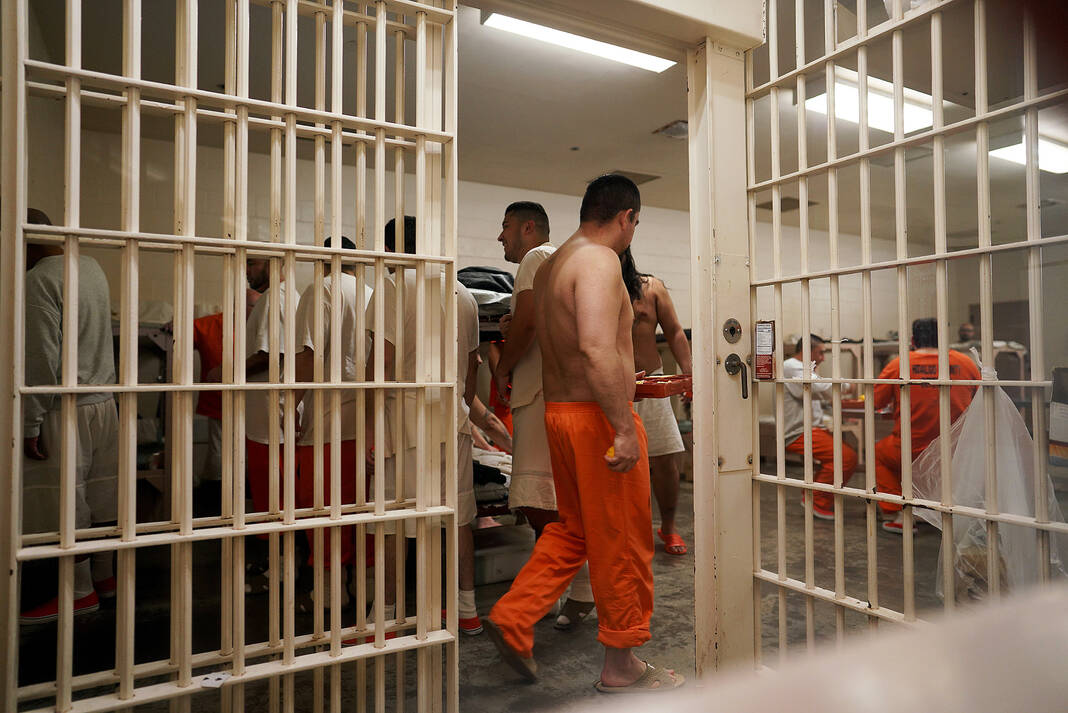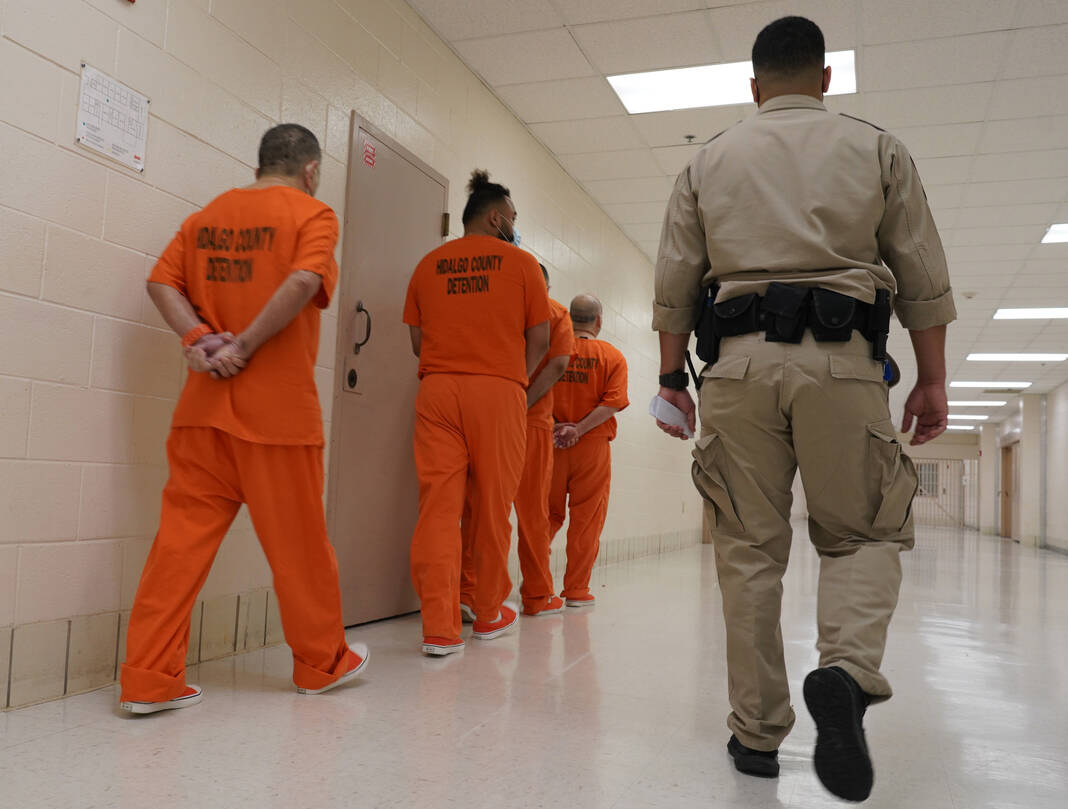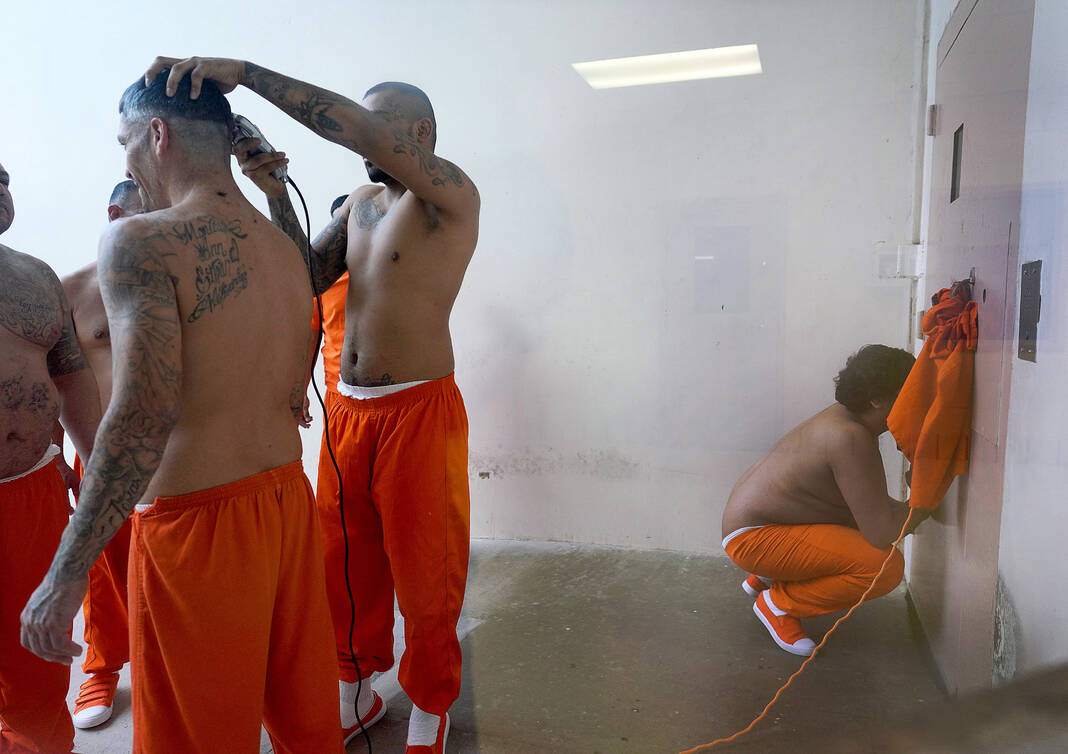Editor’s note: This is the first in a three-part series covering the decades-old overcrowding problem at the Hidalgo County jail.
The Hidalgo County Adult Detention Center had zero beds available for prisoners as of Aug. 1 and it’s going to cost taxpayers a pretty penny to solve the problem.
The jail is overcrowded, according to the latest county population report from the Texas Commission on Jail Standards, or TCJS, the agency that monitors and regulates county jails throughout the state.
That report said the Hidalgo County jail was at 98.46% capacity with a total of 1,410 people incarcerated there as of three months ago.
Of those, 430 were being held in other county jails, which comes at an enormous cost to taxpayers.
“So we will probably, at the end of this fiscal year, I’m going to probably be close to a little over $10 million to house those inmates out of county,” Hidalgo County Sheriff J.E. “Eddie” Guerra said during an Oct. 28 interview.
The jail, which can hold a total of 1,232 people, was completed in 2003 — and just 10 weeks after it opened nearly 20 years ago, it was already at capacity and inmates had to be housed at other facilities outside the county, The Monitor reported at the time.
Since then, taxpayers have footed tens of millions of dollars in costs related to housing inmates outside Hidalgo County.
The state has taken notice, listing the county jail as out of compliance with state standards. During a July 7 inspection, the agency found that an inmate had remained in a holding cell from May 27 until June 3 during booking or during temporary holding. The agency said inmates in this situation cannot be held for more than 48 hours.
Jail administrators blamed overcrowding.
Furthermore, on July 5, the state found the jail exceeded its holding capacity by 72 inmates.

The state outlined capacity requirements in its report.
“The size of the cell shall be determined by the anticipated maximum number of inmates to be confined at any one time,” the report stated. “Cells shall be constructed to house from one to 24 inmates and shall contain not less than 40 square feet of floor space for the first inmate and 18 square feet of floor space for each additional inmate to be confined.”
In August, Hidalgo County jail chief Steve Herrera went to Austin to present solutions to TCJS Executive Director Brandon Wood after the commission allowed the county a variance to increase its bed capacity by 100.
Herrera said the county was working with a private jail in Brooks County and a jail in Starr County to add 124 beds, 78 and 46 beds respectively, to help Hidalgo County. Jim Hogg County might help as well, he said, according to the minutes from that meeting.
Herrera also revealed Hidalgo County was planning to lease the Willacy County jail, which has 582 beds, as an interim measure and said he has been working with the commissioners court and Hidalgo County Judge Richard F. Cortez on proposals for expanding the current jail.
50-YEAR LEASE
On Tuesday, Hidalgo County inked a 50-year lease with Willacy County to use its jail to hold inmates. With Willacy’s additional 582 beds, Hidalgo County will now be able to house a total of 1,814 inmates. Hidalgo County taxpayers, however, will shell out a total of $57.53 million through 2046 to house inmates there, paying $3 million a year for the first three years. Rent for the remaining term of the lease can be adjusted after 2046.
The Monitor filed a Texas Public Information Act request with Hidalgo County for copies of appraisal reports for the condition of the building in Willacy County, but civil attorneys with Hidalgo County requested a Texas Attorney General’s opinion to see whether it can keep those reports secret from the public.
Guerra, the sheriff, said that even if the county uses the Willacy County jail to house inmates, it will still likely need to continue to lease beds from prisons in other counties.
“So that’s not going to stop,” he said.
Cortez, the county judge, said securing the lease with Willacy County will help reduce the cost of sending people to prisons in other counties, but he suspects the cost will ultimately continue to go up. It’s not immediately clear when inmates will be transferred to the Willacy County jail, but Cortez said it’s been inspected and officials feel comfortable about its use.
One thing is for certain: the county will not be able to use the facility until it meets TCJS’s standards.
‘I’M NOT SURE WE’RE THERE YET’
Both the sheriff and county judge said the overcrowding at the county jail is a complex issue, but they noted that county and state district judges are working to adjudicate cases to get people either out of prison, or, if found guilty, sent to a state prison.
Cortez would like to see that process sped up and said people charged with non-violent crimes should get reasonable bonds and be released more quickly.
Then there’s the pandemic, which essentially shut down the adjudication of cases for two years and caused a backlog. And there’s also been an increase in people being jailed by the Texas Department of Public Safety, which launched Operation Lone Star, a law enforcement border initiative noted in the minutes of a 2021 TCJS meeting.
Add to it the county’s ever-growing population, which means more arrests. And tack on the county’s poverty rate, which is one of the highest in the nation and prevents people jailed on cash bonds for non-violent offenses to bond out without a personal recognizance bond.
All of those issues have lingered and mounted over three decades that have created what may be an untenable strain, according to Cortez.
Recently, the county implemented a plan to hire more magistrate judges for the county to increase the frequency with which people can get a bond when sent to the county jail.
And, as life turns back to normal following the pandemic, the newspaper has noted an increase in plea hearings at the courthouse and in trials.
Cortez said there’s a lot of different information going around, and at the end of the day, officials need to reconcile differences to resolve the overcrowding at the jail for the betterment of the community.
“I feel comfortable that we can all sit down and come up with something fair and equitable and get to the point and say we’ve done everything we can to mitigate the need for jail space and there is nothing else we can do except to build more space,” Cortez said. “But right now, I’m not sure we’re there yet.”

‘ASTRONOMICAL’ COST
The need for more bed space is a problem that has plagued Hidalgo County for decades, and the costly solution is not lost on officials.
In 2021, the Hidalgo County Commissioners Court approved a $100,000 study to look at options and the costs associated with expanding a facility that was designed more than two decades ago.
The Monitor filed a Texas Public Information Act request for a copy of the feasibility study and any associated reports.
But just like the newspaper’s request for reports on the Willacy County jail, the county’s civil attorneys are asking the AG to keep a large portion of the study secret from the public.
The county did release a redacted executive summary of a feasibility study ERO Architects conducted, which showed three expansion options for the jail.
ERO’s preferred option would be to add 1,536 beds to the county jail for a total of 2,768 beds. Its second option would add 1,152 beds for a total of 2,354 beds, and its last option would be to add 768 beds for a total of 2,000 beds.
The report notes that the preferred option would eliminate the need to house inmates at facilities outside of the county and would provide an estimated growth space until 2040 based on population assumptions and incarceration rates.
In 2003, the report estimated the county’s population at 631,053. In 2020, the population was estimated at 1,032,926 — a 38% increase. The most recent report projects Hidalgo County’s population will increase by 19% from 2020 to 2050 and describes the county as being the fastest growing in the state, region and nation.
The sheriff said he prefers ERO’s first option to build more bed space, and if the county picks this option, he said he would pursue a contract with the U.S. Marshal to lease beds for federal inmates, which would help offset some of the cost.
As for the second option, the report notes that it also would eliminate the need to house inmates in other counties, but it would only provide additional growth space until 2028 or 2030, meaning in less than a decade, the county would again need to expand to avoid housing inmates outside the county.
However, it should be noted that the feasibility study was finished in March, and it’s unclear whether the Willacy County jail lease was factored into any of the calculations.
The final option would not achieve the county’s goal of bringing home all inmates housed outside the county.
“Due to the true population/incarceration rate and new courthouse impact that will begin in 2022 the current approach to incarceration is not sustainable based on discussions with the Sheriff’s Office,” the report noted.
As for the cost, the report said it’s under review due to the volatility of construction prices and noted it will continue to be evaluated.
“The affordability of the total cost will need to be considered, as it also provides the greatest potential cost savings by eliminating the need for transportation and housing inmates out of county for long periods of time,” the report said.
The county judge, however, said the cost of expanding the jail would be “astronomical.”
When pressed, Cortez said it could cost about $260 million, though he cautioned it was only a rough estimate.
The sheriff also said the cost could be in the hundreds of millions.
Cortez, who highlighted his financial background in banking, said predicting the future is risky business and noted there are a host of factors — including timing — that could affect the total cost of the inevitable expansion.
He pointed to the lingering pandemic impact on the supply chain, which has driven up the cost of construction materials and resulted in supply shortages.
Then there’s Hidalgo County’s sole source of revenue: property taxes. Cortez, who also sits on the board of a bank, said he believes real estate is overvalued and predicted an adjustment that will bring real estate values down, which in turn might mean a loss in tax revenue for Hidalgo County.
He’s also concerned about the burden on future taxpayers, while also considering the burden on the current generation, which is already shouldering the cost of the new courthouse.
And while Cortez admits the costly expansion of the jail is inevitable, he also said the lease with Willacy County buys the county time to explore all of its options.
“So I thought we were very lucky,” Cortez said. “It gives us more room and a little more time to plan for the inevitable construction of additional beds in the prison.”
But he also noted that Hidalgo County is mandated by the state to meet certain jail standards.
“You know, we are mandated by the state of Texas to provide that detention center, and if we don’t do it, they’ll come here and do it for us and send us a bill,” the county judge said.




